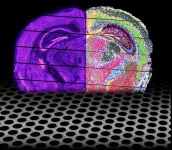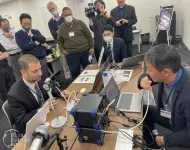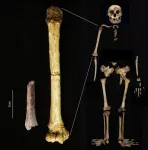(Press-News.org) Electronic waste, or e-waste, is a rapidly growing global problem, and it’s expected to worsen with the production of new kinds of flexible electronics for robotics, wearable devices, health monitors, and other new applications, including single-use devices.
A new kind of flexible substrate material developed at MIT, the University of Utah, and Meta has the potential to enable not only the recycling of materials and components at the end of a device’s useful life, but also the scalable manufacture of more complex multilayered circuits than existing substrates provide.
The development of this new material is described this week in the journal RSC: Applied Polymers, in a paper by MIT Professor Thomas J. Wallin, University of Utah Professor Chen Wang, and seven others.
“We recognize that electronic waste is an ongoing global crisis that’s only going to get worse as we continue to build more devices for the internet of things, and as the rest of the world develops,” says Wallin, an assistant professor in MIT’s Department of Materials Science and Engineering. To date, much academic research on this front has aimed at developing alternatives to conventional substrates for flexible electronics, which primarily use a polymer called Kapton, a trade name for polyimide.
Most such research has focused on entirely different polymer materials, but “that really ignores the commercial side of it, as to why people chose the materials they did to begin with,” Wallin says. Kapton has many advantages, including excellent thermal and insulating properties and ready availability of source materials.
The polyimide business is projected to be a $4 billion global market by 2030. “It’s everywhere, in every electronic device basically,” including parts such as the flexible cables that interconnect different components inside your cellphone or laptop, Wang explains. It’s also widely used in aerospace applications because of its high heat tolerance. “It’s a classic material, but it has not been updated for three or four decades,” he says.
However, it’s also virtually impossible to melt or dissolve Kapton, so it can’t be reprocessed. The same properties also make it harder to manufacture the circuits into advanced architectures, such as multilayered electronics. The traditional way of making Kapton involves heating the material to anywhere from 200 to 300 degrees Celsius. “It’s a rather slow process. It takes hours,” Wang says.
The alternative material that the team developed, which is itself a form of polyimide and therefore should be easily compatible with existing manufacturing infrastructure, is a light-cured polymer similar to those now used by dentists to create tough, durable fillings that cure in a few seconds with ultraviolet light. Not only is this method of hardening the material comparatively fast, it can operate at room temperature.
The new material could serve as the substrate for multilayered circuits, which provides a way of greatly increasing the number of components that can be packed into a small form factor. Previously, since the Kapton substrate doesn’t melt easily, the layers had to be glued together, which adds steps and costs to the process. The fact that the new material can be processed at low-temperature while also hardening very quickly on demand could open up possibilities for new multilayer devices, Wang says.
As for recyclability, the team introduced subunits into the polymer backbone that can be rapidly dissolved away by an alcohol and catalyst solution. Then, precious metals used in the circuits, as well as entire microchips, can be recovered from the solution and reused for new devices.
“We designed the polymer with ester groups in the backbone,” unlike traditional Kapton, Wang explains. These ester groups can be easily broken apart by a fairly mild solution that removes the substrate while leaving the rest of the device unharmed.
“We break the polymer back into its original small molecules. Then we can collect the expensive electronic components and reuse them,” Wallin adds. “We all know about the supply chain shortage with chips and some materials. The rare earth minerals that are in those components are highly valuable. And so we think that there’s a huge economic incentive now, as well as an environmental one, to make these processes for the recapture of these components.”
The research team included Caleb Reese and Grant Musgrave at the University of Utah, and Jenn Wong, Wenyang Pan, John Uehlin, Mason Zadan and Omar Awartani at Meta’s Reality Labs in Redmond, Washington. The work was supported by a startup fund at the Price College of Engineering at the University of Utah.
###
Written by David L. Chandler, MIT News
Paper: “Photopatternable, degradable, and performant polyimide network substrates for e-waste mitigation”
http://doi.org/10.1039/D4LP00182F
END
New substrate material for flexible electronics could help combat e-waste
Electronic waste is a rapidly growing problem, but this degradable material could allow the recycling of parts from many single-use and wearable devices
2024-08-06
ELSE PRESS RELEASES FROM THIS DATE:
Johns Hopkins Medicine scientists probe molecular cause of COVID-19 related diarrhea, revealing potential treatments
2024-08-06
Working with human stem cells that form a kind of “mini intestine-in-a-dish,” Johns Hopkins Medicine scientists say they have found several molecular mechanisms for COVID-19-related diarrhea, suggesting potential ways to control it.
Details of the experiments in a model of human intestinal tissue, called enteroids, are described on July 30 in Cellular and Molecular Gastroenterology and Hepatology.
Along with the unpleasant aches, fever, sore throat, cough, respiratory distress and other symptoms that may accompany COVID-19 infection, up to half of people who get the virus will experience diarrhea. Some 30% of them will go on to develop ...
New open-source platform for high-resolution spatial transcriptomics
2024-08-06
Leuven, 6 August 2024 - A team of researchers from the lab of Prof. Stein Aerts (VIB-KU Leuven) presents Nova-ST, a new spatial transcriptomics technique that promises to transform gene expression profiling in tissue samples. Nova-ST will make large-scale, high-resolution spatial tissue analysis more accessible and affordable, offering significant benefits for researchers. The research was published in Cell Reports Methods.
Transcriptomics is the study of gene expression in a cell or a population of cells, but it usually does not include spatial information about where those genes were active. This hurdle limited our understanding of complex ...
Targeted cancer therapy: initial high concentration may slow down selection for resistance
2024-08-06
BUFFALO, NY- August 6, 2024 – On July 28, 2024, Mikhail V. Blagosklonny M.D., Ph.D., from Roswell Park Comprehensive Cancer Center published a new editorial in Volume 16, Issue 14 of Aging (listed by MEDLINE/PubMed as "Aging (Albany NY)" and "Aging-US" by Web of Science), entitled, “Targeted cancer therapy: the initial high concentration may slow down the selection for resistance.”
“Unfortunately, any targeted therapy is, always, started with low levels of the drug in the organism, selecting for drug resistance. One should propose that initial drug levels must be maximized, ...
Lehigh University researchers dig deeper into stability challenges of nuclear fusion—with mayonnaise
2024-08-06
Mayonnaise continues to help researchers better understand the physics behind nuclear fusion.
“We’re still working on the same problem, which is the structural integrity of fusion capsules used in inertial confinement fusion, and Hellmann’s Real Mayonnaise is still helping us in the search for solutions,” says Arindam Banerjee, the Paul B. Reinhold Professor of Mechanical Engineering and Mechanics at Lehigh University and Chair of the MEM department in the P.C. Rossin College of Engineering and Applied Science.
In simple terms, fusion reactions are what power the sun. If the process could ...
Texas Tech professor receives grant for printable semiconductors research
2024-08-06
Minxiang “Glenn” Zeng, an assistant professor in the Department of Chemical Engineering at Texas Tech University, has been awarded a $250,000 grant from the Launching Early-Career Academic Pathways in the Mathematical and Physical Sciences (LEAPS-MPS) award from the National Science Foundation (NSF) to further his research about printable semiconductors and electronics under extreme environments.
The grant supports Zeng’s work in understanding and controlling the thermal degradation pathways of printed metal chalcogenides, which are semiconductor materials including selenides, tellurides and sulfides. His goal is to develop strategies to enhance the thermal stability ...
Digital Olfaction Society 2024: Revolutionizing scent digitization and global transfer
2024-08-06
The 8th Annual Meeting of the Digital Olfaction Society (DOS) will take place on December 5-6, 2024, in Tokyo, Japan, and Online. The DOS meeting is uniquely aimed at digitizing scents, transferring them, and re-creating them in different parts of the world. The two-day event includes one day dedicated to talks and another day for demonstrations. Under the slogan "Olfaction to Digital Olfaction", the congress will explore the latest advances in olfaction science and digital olfaction technologies, highlighting their transformative impact across multiple fields.
The first day of the congress will focus on olfaction science, scent-based diagnosis and treatment ...
New York City’s fireworks display prompts temporary surge of air pollution
2024-08-06
In 2023, roughly 60,000 firework shells exploded above Manhattan’s East River as part of Macy’s Fourth of July show. The resulting air pollutant levels were many times higher in the hours after the display than those seen when smoke from a Canadian wildfire had blanketed the area a month before.
This is according to the results of a new study, led by researchers at NYU Langone Health, which measured air quality just before and after the Independence Day event, one of the largest in the United States. Tiny particles of hazardous metals and organic compounds peaked at 3,000 micrograms per cubic meter at an air sampling site ...
Smallest arm bone in human fossil record sheds light on the dawn of Homo floresiensis
2024-08-06
A paper out today in Nature Communications reports the discovery of extremely rare early human fossils from the Indonesian island of Flores, including an astonishingly small adult limb bone.
Dated to about 700,000 years old, the new findings shed light on the evolution of Homo floresiensis, the so-called ‘Hobbits’ of Flores whose remains were uncovered in 2003 at Liang Bua cave in the island’s west by a team co-led by Australian-New Zealand archaeologist Professor Mike Morwood (1950–2013).
Archaeological evidence suggests these diminutive, small-brained humans inhabited Liang Bua ...
Type 2 diabetes and fracture risk in older women
2024-08-06
About The Study: The results from this study suggest that the higher fracture risk among older women with type 2 diabetes may be due to impaired physical function and not skeletal characteristics.
Corresponding Author: To contact the corresponding author, Mattias Lorentzon, MD, PhD, email mattias.lorentzon@medic.gu.se.
To access the embargoed study: Visit our For The Media website at this link https://media.jamanetwork.com/
(doi:10.1001/jamanetworkopen.2024.25106)
Editor’s Note: Please see the article for additional information, including other authors, author contributions and affiliations, conflict of interest and financial disclosures, and funding and ...
AI for early detection of pediatric eye diseases using mobile photos
2024-08-06
About The Study: In this cross-sectional study, the artificial intelligence (AI) model demonstrated strong performance in accurately identifying myopia, strabismus, and ptosis using only smartphone images. These results suggest that such a model could facilitate the early detection of pediatric eye diseases in a convenient manner at home.
Corresponding Authors: To contact the corresponding authors, email Lin Li, MD, PhD (jannetlee130@gmail.com), and Jie Xu, DHM (xujie@pjlab.org.cn).
To access the embargoed ...
LAST 30 PRESS RELEASES:
Scientists trace microplastics in fertilizer from fields to the beach
The Lancet Obstetrics, Gynecology, & Women’s Health: Taking paracetamol during pregnancy does not increase risk of autism, ADHD or intellectual disabilities, confirms new gold-standard evidence review
Taking paracetamol during pregnancy does not increase risk of autism, ADHD or intellectual disabilities
Harm reduction vending machines in New York State expand access to overdose treatment and drug test strips, UB studies confirm
University of Phoenix releases white paper on Credit for Prior Learning as a catalyst for internal mobility and retention
Canada losing track of salmon health as climate and industrial threats mount
Molecular sieve-confined Pt-FeOx catalysts achieve highly efficient reversible hydrogen cycle of methylcyclohexane-toluene
Investment in farm productivity tools key to reducing greenhouse gas
New review highlights electrochemical pathways to recover uranium from wastewater and seawater
Hidden pollutants in shale gas development raise environmental concerns, new review finds
Discarded cigarette butts transformed into high performance energy storage materials
Researchers highlight role of alternative RNA splicing in schizophrenia
NTU Singapore scientists find new way to disarm antibiotic-resistant bacteria and restore healing in chronic wounds
Research suggests nationwide racial bias in media reporting on gun violence
Revealing the cell’s nanocourier at work
Health impacts of nursing home staffing
Public views about opioid overdose and people with opioid use disorder
Age-related changes in sperm DNA may play a role in autism risk
Ambitious model fails to explain near-death experiences, experts say
Multifaceted effects of inward foreign direct investment on new venture creation
Exploring mutations that spontaneously switch on a key brain cell receptor
Two-step genome editing enables the creation of full-length humanized mouse models
Pusan National University researchers develop light-activated tissue adhesive patch for rapid, watertight neurosurgical sealing
Study finds so-called super agers tend to have at least two key genetic advantages
Brain stimulation device cleared for ADHD in the US is overall safe but ineffective
Scientists discover natural ‘brake’ that could stop harmful inflammation
Tougher solid electrolyte advances long-sought lithium metal batteries
Experts provide policy roadmap to reduce dementia risk
New 3D imaging system could address limitations of MRI, CT and ultrasound
First-in-human drug trial lowers high blood fats
[Press-News.org] New substrate material for flexible electronics could help combat e-wasteElectronic waste is a rapidly growing problem, but this degradable material could allow the recycling of parts from many single-use and wearable devices




